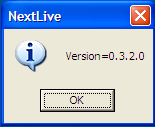ADW_NEXTLIVE
AdWare.Win32.Agent.ahgx(Kaspersky),Win32/NextLive.A application(NOD32),Adware.Agent(Sunbelt)
Windows 2000, Windows Server 2003, Windows XP (32-bit, 64-bit), Windows Vista (32-bit, 64-bit), Windows 7 (32-bit, 64-bit)


Threat Type: Adware
Destructiveness: No
Encrypted:
In the wild: Yes
OVERVIEW
Downloaded from the Internet, Dropped by other malware
This adware arrives on a system as a file dropped by other malware or as a file downloaded unknowingly by users when visiting malicious sites. It arrives as a component bundled with malware/grayware packages.
It does not have any propagation routine.
It does not have any backdoor routine.
It requires its main component to successfully perform its intended routine.
TECHNICAL DETAILS
19,212,408 bytes
EXE
Yes
18 Mar 2014
Arrival Details
This adware arrives on a system as a file dropped by other malware or as a file downloaded unknowingly by users when visiting malicious sites.
It arrives as a component bundled with malware/grayware packages.
Installation
This adware drops the following component file(s):
- %Application Data%\newnext.me\nengine.cookie
- %Application Data%\newnext.me\nengine.cookie-journal - (delete afterwards)
- %Application Data%\newnext.me\log\nengine{YEAR}{MONTH}{DATE}_{random}.log
- %Application Data%\newnext.me\cache\id.txt
(Note: %Application Data% is the Application Data folder, where it usually is C:\Documents and Settings\{user name}\Application Data on Windows 2000, Windows Server 2003, and Windows XP (32- and 64-bit); C:\Users\{user name}\AppData\Roaming on Windows Vista (32- and 64-bit), Windows 7 (32- and 64-bit), Windows 8 (32- and 64-bit), Windows 8.1 (32- and 64-bit), Windows Server 2008, and Windows Server 2012.)
It drops the following copies of itself into the affected system:
- %Application Data%\newnext.me\nengine.dll
(Note: %Application Data% is the Application Data folder, where it usually is C:\Documents and Settings\{user name}\Application Data on Windows 2000, Windows Server 2003, and Windows XP (32- and 64-bit); C:\Users\{user name}\AppData\Roaming on Windows Vista (32- and 64-bit), Windows 7 (32- and 64-bit), Windows 8 (32- and 64-bit), Windows 8.1 (32- and 64-bit), Windows Server 2008, and Windows Server 2012.)
It creates the following folders:
- %Application Data%\newnext.me
- %Application Data%\newnext.me\cache
(Note: %Application Data% is the Application Data folder, where it usually is C:\Documents and Settings\{user name}\Application Data on Windows 2000, Windows Server 2003, and Windows XP (32- and 64-bit); C:\Users\{user name}\AppData\Roaming on Windows Vista (32- and 64-bit), Windows 7 (32- and 64-bit), Windows 8 (32- and 64-bit), Windows 8.1 (32- and 64-bit), Windows Server 2008, and Windows Server 2012.)
It adds the following mutexes to ensure that only one of its copies runs at any one time:
- Global\{CLSID}
Autostart Technique
This adware adds the following registry entries to enable its automatic execution at every system startup:
HKEY_CURRENT_USER\Software\Microsoft\
Windows\CurrentVersion\Run
NextLive = "%System%\rundll32.exe "%Application Data%\newnext.me\nengine.dll",EntryPoint -m l"
Propagation
This adware does not have any propagation routine.
Backdoor Routine
This adware does not have any backdoor routine.
Download Routine
This adware saves the files it downloads using the following names:
- %Application Data%\newnext.me\cache\spark.bin
(Note: %Application Data% is the Application Data folder, where it usually is C:\Documents and Settings\{user name}\Application Data on Windows 2000, Windows Server 2003, and Windows XP (32- and 64-bit); C:\Users\{user name}\AppData\Roaming on Windows Vista (32- and 64-bit), Windows 7 (32- and 64-bit), Windows 8 (32- and 64-bit), Windows 8.1 (32- and 64-bit), Windows Server 2008, and Windows Server 2012.)
Other Details
This adware requires its main component to successfully perform its intended routine.
NOTES:
It downloads an updated copy of itself.
This adware requires the following parameters to install itself in the system:
-m i
-m l
-m r
-m t
This adware gathers the following information:
- Identification
- IP address
- Register Area
It sends the gathered information in the following URL:
- http://{BLOCKED}t.{BLOCKED}t.me/register.php?ver={string1}&hardcode={string2}&partner={string3}
After the installation, it displays the following message box:

SOLUTION
9.700
1.480.36
04 Feb 2014
Step 1
Before doing any scans, Windows XP, Windows Vista, and Windows 7 users must disable System Restore to allow full scanning of their computers.
Step 2
Restart in Safe Mode
Step 3
Delete this registry value
Important: Editing the Windows Registry incorrectly can lead to irreversible system malfunction. Please do this step only if you know how or you can ask assistance from your system administrator. Else, check this Microsoft article first before modifying your computer's registry.
- In HKEY_CURRENT_USER\Software\Microsoft\Windows\CurrentVersion\Run
- NextLive = "%System%\rundll32.exe "%Application Data%\newnext.me\nengine.dll",EntryPoint -m l"
- NextLive = "%System%\rundll32.exe "%Application Data%\newnext.me\nengine.dll",EntryPoint -m l"
Step 4
Search and delete these folders
- %Application Data%\newnext.me
Step 5
Restart in normal mode and scan your computer with your Trend Micro product for files detected as ADW_NEXTLIVE. If the detected files have already been cleaned, deleted, or quarantined by your Trend Micro product, no further step is required. You may opt to simply delete the quarantined files. Please check this Knowledge Base page for more information.
Step 6
Scan your computer with your Trend Micro product to delete files detected as ADW_NEXTLIVE. If the detected files have already been cleaned, deleted, or quarantined by your Trend Micro product, no further step is required. You may opt to simply delete the quarantined files. Please check this Knowledge Base page for more information.
Did this description help? Tell us how we did.
